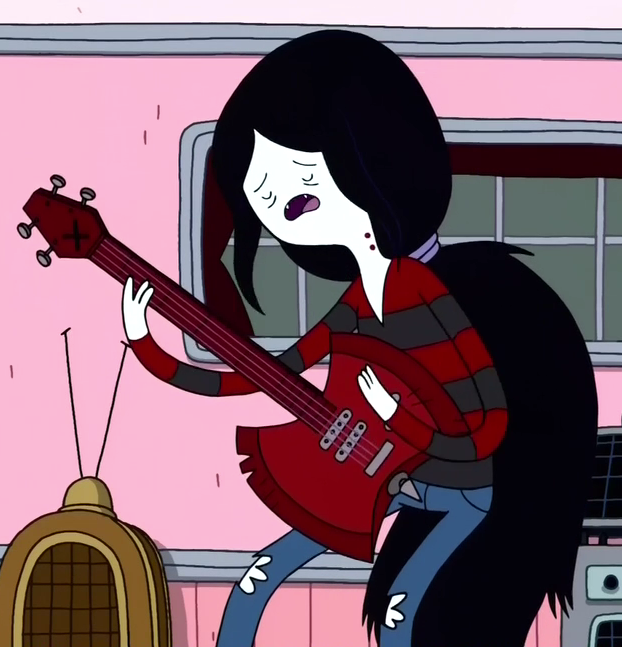There’s Something About Rebecca Sugar’s Songwriting
a distinct use of the fictional major third chord and the legendary 2/5/1 and what it means in Adventure Time and Steven Universe
I was watching Adventure Time a month ago when I heard my favorite character (maybe even objectively best character) Marceline break out into song. Immediately, in her emotional number about her dad not respecting her fry boundaries, there was a little something in the chords-not there, but there!-that sent me back to a half a year before when I watched Steven Universe. After a quick Google search, my suspicions had been confirmed as I found out that Rebecca Sugar, the creator and one of the music composers of Steven Universe was a part of the Adventure Time team before, and you can bet that she was responsible for Marceline’s song.

Intrigued, I started to go through Rebecca Sugar’s songs in both shows, one by one, writing out roman numeral notation and chordal analysis on the hunt for an answer. In this article, I’m going to be breaking down songs written by Sugar and sung by characters on screen and highlighting exactly what it is about the chordal patterns that makes their songs so uniquely hers.
One of the most Sugar-specific techniques is that of the fictional major 3 chord. In the most simplistic of explanations, the ‘major 3 chord,’ or V/vi in proper roman numeral notation, exists as a major chord whose root is the 3rd note of the scale of whichever key is being used. Stay with me here. In the key of C major, this chord would be an E major, or in G major, this chord would be a B major.
The use of this type of chord is important in Western music theory because it exists outside the natural key (either minor or major) of the song, sticking out of the expected tones and creating a massive amount of tension. Sugar’s choice to use this chord in their songwriting does a great job of reflecting the internal stress of characters; the chord that succeeds it often underlines whether the character singing will resolve the issue sooner or later (being either a minor/major 4 chord or trailing off). The melody line of Sugar’s songs accentuates these chord choices, often containing note values unique to the chord and separate of the key (such as a raised 5th acting as the third of the V/vi chord).
Okay, but what does this mean for the characters?
Most of Marceline’s iconic solos written by Sugar contain this technique, including Fry Song, Everything Stays, I Remember You, and her opposing gender performance of Good Little Girl/Bad Little Boy. In all of these songs, indicative of Marceline’s character arc, she is battling her past and present, finding struggle between the dichotomy of evil and good, wise vampire and teenage girl. The tension of the V/vi chord musically articulates that.
Finn and Jake have their own songs that use this technique as well, including Finn’s relationship lament “All Gummed Up Inside” and Jake’s lullaby “Sleepy Puppies.”
Neglected but not forgotten is Sugar’s reliance in Steven Universe of the 2/5/1, 4/5/1, and even 2/5/1 reversal chord progression. Now of course, the use of 2/5/1 and 4/5/1 as a chord progression is by no means special, and any musician ever, especially in jazz, knows the importance of the 2/5/1 as it applies to finalizing a song and “returning home.” To explain, the 2/5/1 or 4/5/1 is simply the second chord in the key, followed by the fifth, and then lastly the root. Adhering to musical grammar, the 2/5/1 is assumed to be the minor 2, the major 5, and the major 1, as 4/5/1 is assumed to be the major 4, the major 5, and the major 1. In C major, a 2/5/1 ending would look like a D minor chord followed by a G major chord, and resolving on the root C major chord. These progressions are everywhere in music, and to the western ear, such a progression is connotatively associated with the ending of a song given its light tension and resolve.
I ask again, what does this mean for the characters?
Juxtaposing the use of this progression in Steven Universe versus its absence in Adventure Time aptly reflects the themes of each show: Steven focuses on themes of family and that sense of “returning home,” (whatever that looks like for him), whereas Adventure Time has a less rigid storytelling design and opts for the more random, at least in the beginning seasons.
Similarly, while Adventure Time is plagued with the tense ‘major 3 chords’ we just discussed, the music in Steven is used as more of a conclusion to a problem, seen in songs like “Peace and Love on the Planet Earth,” “Be Wherever You Are,” “Jam Song,” “Change Your Mind,” and “I’d Rather Be Me With You,” which all utilize a version of the 2/5/1 to symbolize resolution.
Additionally, the Crystal Gems theme song that plays at the beginning of every episode contains a ‘major 3 chord’ and lacks a 4/5/1 resolution, perhaps symbolizing the start of tension, the start of a problem, and simultaneously the start of an episode.
There is much speculation that can go into musical analysis and what it means for the plot, but Sugar’s frequent use of V/vi and 2/5/1 represent solid themes of the respective shows and is indicative of Sugar’s talent of reflecting character crises and feelings in chordal patterns.
Reader, this is my first entry on Medium; thank you so much for reading.




